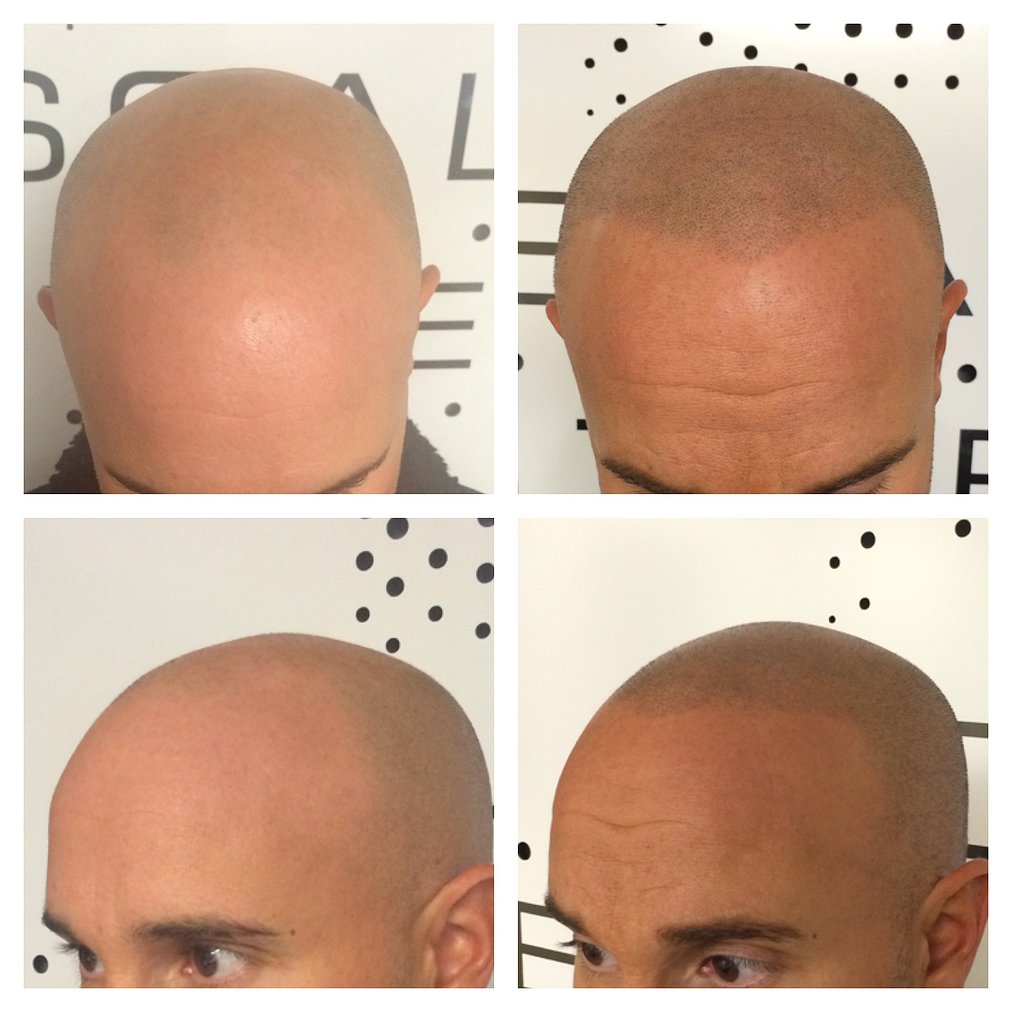“It looks so realistic that no one will be able to tell the difference.”
For many, hair loss is just another symbol of growing older. As hairlines recede, considerations for remedies commence. Hair transplants can be expensive, invasive and are not to everyone’s taste. And while toupees and comb overs offer comfort to some, others are not satisfied with these options. Until recently, these have been the primary choices when confronted with hair loss.
“Micropigmentation gives clients another option to help them with their hair loss concerns,” says Tino Barbone from the Scalp Micropigmentation Center in Toronto, Canada. “For men and women that have thinning hair and don’t want a hair transplant or who cannot afford a hair transplant, we can now cover the scalp with thousands of simulated hair follicles to give them the look of a fuller, thicker, denser head of hair,” says Barbone.
Micropigmentation is a procedure where a professional repeatedly inserts a single needle the size of a hair follicle into the shallow layer of the scalp. Injecting grey or black pigments into the scalp simulates the hair follicle of a freshly shaved head. “It looks so realistic that no one will be able to tell the difference,” says Barbone. Micropigmentation fills in hairless areas or bolsters thinning locations on the scalp and also helps camouflage head scarring.
To be fully effective, three treatments of 2-3 hours each are required. “The artist starts with the hairline and works their way back throughout the top of the head, seamlessly blending the pigment with the sides and back,” explains Eric Taylor, Global Operations Manager for Scalp Aesthetics. “Follow-up appointments are required to make sure the ink has settled properly and the client is happy with the density of the simulated hair and their hairline.”

Not Just a Tattoo: How Scalp Micropigmentation Is Performed
Micropigmentation may share certain characteristics with traditional tattooing but the two should not be confused. In both procedures, a needle injects pigment in the skin to create a mark, but that’s where the similarities end. Micropigmentation and traditional forms of tattooing differ in almost every other procedural aspect.
First and foremost, while tattoos are generally considered to be permanent, micropigmentation is not. “Micropigmentation is intended to fade over time and should not last a lifetime,” cautions Barbone. “We advise clients that we prefer that the dots fade completely over time—from one to three years—and have them return once every year or so for simple touch-ups.”
“We don’t want the simulated hair follicle to grow any bigger, morph or migrate,” says Barbone. While traditional tattoos stretch and fade over time as the skin changes, micropigmentation would lose its realistic effect if it did the same.
In part, the transient nature of micropigmentation is a result of another difference between it and traditional tattooing: pigment placement within the skin. Traditional tattooing can place pigments at two millimeters beneath the outer layer of skin.
“We have only one- to one-and-a-half millimeters of skin in which to insert the pigment,” Barbone outlines. “This means we are in the epidermis, which sheds every four to six weeks, so the dot will disappear.”
Micropigmentation ink cannot be inserted any deeper than one and a half millimeters beneath the skin or it distorts the desired effect. “If we go too deep, then we get what is called a ‘blow out,’” says Barbone. “This results in a large dot which does not resemble a hair follicle and ruins the treatment. We would rather go too shallow than too deep.”
Another important distinction between tattooing and micropigmentation is the type of ink used. “Our ink is strictly organic charcoal, unlike that used for tattooing which has derivatives like metallics and dyes,” states Scalp Aesthetics’ Eric Taylor.
The nature of the procedure also allows for quicker recovery than traditional tattooing. While tattoos take a minimum of two weeks to heal, with severe scabbing occurring during this period, the micropigmentation process takes mere days.
“The scalp will be red and slightly swollen for two to six hours and in 24 to 48 hours, will be fully healed,” declares Barbone. Hair transplants can take up to ten days to heal with full results requiring roughly six months. “Sixty-five percent of our clients were left with a scar from a hair transplant,” says Taylor. “Now, not only does the client want the top of their head done, there’s also a scar to camouflage.”
Tattoos also come with extensive lists of procedures to follow during healing, such as applying specific hydrating skincare products and abstaining from swimming. “Because micropigmentation is not a regular body tattoo, no Vaseline, saran wrap or gauze is needed to cover the area,” says Barbone. “We simply apply a little Polysporin, or hand them a shower cap to put on if they want to wear a hat or tuque after the treatment to go home.”
The only special care required is to avoid getting the head wet for a minimum of 24 hours. Removing a traditional tattoo is a costly, time-consuming process. Depending on the location and colors used, tattoo removal can take between three and ten sessions for laser removal with a recommended six weeks between treatments. This means that removing a tattoo can take between four and fourteen months, while complications can lead to scarring.
Micropigmentation, on the other hand, is easily altered. “With micropigmentation, we’re so shallow we’re able to use light therapy to remove the pigmentation, however, most clients would just let it fade over time,” says Barbone. “To date, we’ve never had to correct or remove our micropigmentation work.”
A Growing Trend in the Industry
Barbone has worked in micropigmentation for four years. In that time, he’s seen a massive shift in attitudes towards the procedure. “When I first started I was only getting one call a month about micropigmentation,” says Barbone. “But now that this procedure has come to the forefront of the industry, we’re booking four to six weeks in advance and performing two or three treatments every day.”
The procedure used to be a last resort for people with hair loss, but now many see it as an alternative to traditional methods of dealing with the problem. “Micropigmentation has become more popular and less taboo. Today it’s in the conversation at hair transplant clinics, salons, medspas, along with hair loss shows and conventions,” notes Barbone.
Taylor is a strong advocate for micropigmentation. After having the procedure done on his own scalp, he was convinced that he needed to preach the virtues of micropigmentation to rest of the world. “I left my profession as a business development manager at a national marketing agency two weeks after having the procedure done and have never looked back,” remarks Taylor.
Barbone, on the other hand, has yet to receive the treatment himself. “I haven’t had a full procedure done because A) I am happy with my hair, and B) I can’t do my own micropigmentation treatment and rarely trust other providers.”
He does place faith in his students, however, and is currently training micropigmentation specialists that he says are eager to work on his scalp. “The first one to reach 100 completed heads will be able to do my head,” quips Barbone, “So far, we have one student with nearly 50 heads under him, so he is in the lead to do my head.”









